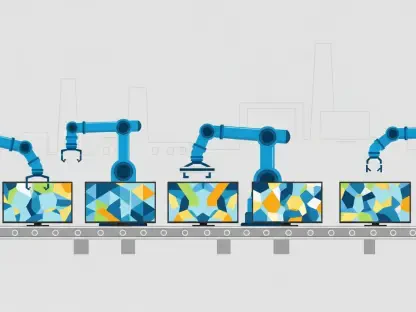In an era where telecom networks are the backbone of global connectivity, managing vast and complex infrastructure poses significant challenges for mobile network operators (MNOs), tower companies (towercos), and infrastructure providers (infracos). Enter digital twins—virtual replicas of physical assets that are reshaping how the industry operates by providing real-time, accurate representations of network components. This technology is not just a novelty; it’s becoming a cornerstone for tackling outdated data, reducing operational inefficiencies, and driving strategic decision-making. As telecom companies strive to keep pace with growing demands for connectivity, digital twins offer a transformative solution, creating a unified view of sprawling networks that was once unimaginable. With innovative players like vHive leading the charge through autonomous drones and software-as-a-service (SaaS) platforms, the promise of a “single source of truth” for physical infrastructure is now within reach. This article delves into the profound ways digital twins are revolutionizing telecom infrastructure management, from slashing costs to enabling smarter mergers and acquisitions (M&A). The journey of this technology unfolds as a game-changer, poised to redefine the future of the sector.
Unlocking the Value of Accurate Data
Digital twins are addressing a critical pain point in the telecom industry: the pervasive issue of inaccurate and outdated infrastructure data that has long plagued operators. Traditional methods, often reliant on manual data collection, are riddled with human error and struggle to scale with the complexity of modern networks. Through cutting-edge technology, companies like vHive deploy autonomous drones to capture real-time field data with exceptional precision. This ensures a dependable foundation for all subsequent operations, eliminating the guesswork that once dominated asset management. The significance of this accuracy cannot be overstated, as it forms the bedrock of any meaningful digital transformation in the sector. By providing a reliable dataset, digital twins enable a level of trust in infrastructure information that was previously unattainable, setting the stage for broader innovation.
Moreover, this precision fosters cross-departmental collaboration within telecom organizations, a feat that was often hindered by inconsistent data in the past. Engineering teams, sales divisions, and maintenance crews can now access a unified, trustworthy repository of information, ensuring everyone operates from the same page. This alignment minimizes discrepancies that could derail projects or inflate costs, creating a seamless workflow across functions. As highlighted by industry leaders, such accuracy isn’t just a luxury but a fundamental requirement for progress. Digital twins, by delivering this “single source of truth,” empower companies to make informed decisions with confidence, paving the way for more efficient and effective management of their sprawling networks.
From Raw Data to Strategic Insights
The evolution of digital twins goes beyond merely collecting data; it lies in their ability to transform that information into actionable insights that drive tangible business value. Unlike static models of the past, today’s digital twins are dynamic tools capable of identifying critical issues such as missing equipment, structural vulnerabilities, or suboptimal installations on telecom towers. Through automated analysis, solutions provided by vHive enable clients to proactively address potential problems before they escalate into costly disruptions. This capability marks a significant shift in how telecom infrastructure is managed, focusing on prevention rather than reaction. The result is not just saved time but also substantial resource conservation, a priority for any operator in a competitive market.
This transition from raw numbers to practical recommendations resonates deeply with the industry’s growing emphasis on performance and efficiency. Telecom companies are no longer satisfied with data for its own sake; they demand insights that translate into measurable outcomes. Digital twins meet this expectation by offering clear guidance on optimizing assets, whether it’s reconfiguring equipment for better performance or identifying maintenance needs early. This focus on actionable outcomes aligns with broader market trends where efficiency isn’t just a goal but a necessity. As digital twins continue to refine their analytical capabilities, their role in shaping strategic decisions becomes even more pronounced, offering a competitive edge to those who adopt them.
Driving Operational Efficiency and Cost Reductions
One of the most compelling advantages of digital twins in telecom infrastructure management is their capacity to enhance operational efficiency while significantly cutting costs. By minimizing the need for physical site visits and reducing errors in installation or maintenance processes, this technology streamlines workflows that were once labor-intensive and error-prone. Equipment deployment, for instance, becomes faster and more precise, as digital twins provide a clear picture of site conditions without the need for on-the-ground inspections. Additionally, digitized site surveys replace traditional methods, slashing annual budgets allocated to fieldwork. The financial benefits are immediate, allowing companies to redirect resources to other critical areas of growth or innovation.
Industry forums like TowerXchange in London have underscored this transformative potential, with experts recognizing digital twins as a powerful means to extract maximum value from existing assets. Beyond cost savings, the technology also uncovers hidden revenue opportunities by identifying overlooked or underutilized assets within a network. This dual impact—reducing expenses while boosting income—positions digital twins as a vital tool for financial optimization. As more telecom operators witness these benefits, the adoption of digital twins is gaining momentum, reshaping how budgets are planned and resources allocated. The ripple effect of such efficiencies extends across the entire operational framework, setting a new standard for infrastructure management.
Revolutionizing Mergers and Acquisitions
Digital twins are proving to be a game-changer in the realm of mergers and acquisitions within the telecom sector, offering unparalleled clarity during complex transactions. By providing an accurate, real-time snapshot of physical assets, this technology enables companies to conduct thorough due diligence with confidence. For instance, organizations like Phoenix Tower International have leveraged vHive’s solutions to uncover discrepancies between documented records and actual site conditions, ensuring that deals are based on factual data. Such transparency is invaluable in mitigating risks associated with asset valuation, preventing costly missteps that could arise from outdated or incorrect information during negotiations.
In diverse markets such as Africa, the application of digital twins has been equally impactful, with clients using the technology to survey thousands of newly acquired sites. This process not only identifies potential safety hazards but also ensures that contract terms accurately reflect the true state of infrastructure, safeguarding both parties in a transaction. This strategic use case has emerged as a cornerstone for long-term business planning, embedding digital twins into the fabric of corporate strategies. As M&A activities continue to shape the telecom landscape, the role of digital twins in providing a reliable foundation for asset evaluation becomes increasingly critical. Their ability to bridge the gap between assumption and reality transforms how deals are structured and executed, fostering trust and precision in high-stakes environments.
Laying the Foundation for Network Optimization
While digital twins are not inherently optimization tools, their role in enabling better network performance is undeniable and forms a crucial part of their value proposition. By revealing discrepancies such as misaligned equipment or incorrect configurations, they ensure that subsequent optimization efforts—often involving radio access network (RAN) software—are built on accurate data. This foundational accuracy is essential for achieving meaningful improvements in coverage and service quality, directly impacting customer satisfaction. For MNOs, the return on investment is often immediate, as corrected infrastructure issues translate into enhanced network reliability and reach, addressing pain points that might otherwise go unnoticed.
This enabling function of digital twins sets them apart as a prerequisite for effective network planning and enhancement. Without a factual starting point, optimization initiatives risk being undermined by underlying errors, wasting both time and capital. Digital twins eliminate this uncertainty by providing a clear, verifiable view of infrastructure conditions, allowing operators to focus on refining performance rather than troubleshooting foundational issues. As telecom networks grow in complexity with the rollout of advanced technologies, the need for such precision becomes even more pronounced. Digital twins thus serve as the critical first step in a broader strategy to ensure networks operate at peak efficiency, meeting the escalating demands of a connected world.
Scaling Up with Seamless Integration
The scalability of digital twins, supported by SaaS models and application programming interfaces (APIs), represents a significant leap forward in their applicability to telecom infrastructure management. Creating a digital twin is now a remarkably swift process, often requiring nothing more than a list of site locations to initiate comprehensive data capture. This speed is a major advantage for operators managing extensive portfolios across diverse geographies, allowing rapid deployment without the delays associated with traditional methods. Companies like vHive have honed this capability, ensuring that telecom providers can digitize assets at scale without disrupting ongoing operations, thereby maintaining business continuity.
Furthermore, the integration of digital twins into existing systems through APIs enhances their utility by facilitating seamless data flow across various organizational functions. Whether it’s engineering, lease management, or sales, these interfaces enable departments to access and utilize digital twin data collaboratively, breaking down silos that once hampered efficiency. As more assets are digitized and connected to broader systems, the value of digital twins compounds, unlocking deeper insights and operational improvements. This interconnectedness is key to realizing the full potential of the technology, transforming it from a standalone tool into a central component of telecom workflows. The result is a more agile, responsive infrastructure management approach that adapts to the evolving needs of the industry.
Pioneering the Future of Infrastructure Management
Reflecting on the journey of digital twins in telecom infrastructure, it’s clear that their adoption marked a pivotal shift in how assets were understood and managed. Industry leaders, through discussions at events like TowerXchange, recognized early on that this technology was not just a fleeting trend but a fundamental evolution, delivering immediate benefits like cost reductions and enhanced network performance. The rigorous validation of data accuracy, even when it revealed unsettling discrepancies, built a foundation of trust that encouraged wider acceptance. Strategic applications in M&A due diligence further demonstrated their versatility, embedding digital twins into critical business processes with lasting impact.
Looking ahead, the next steps for telecom operators involve embracing broader collaboration and leadership commitment to fully harness this technology’s potential. Expanding digital twins beyond traditional towers to diverse assets like urban rooftops and data centers presents an exciting frontier for innovation. Industry-wide data sharing, though challenging, could amplify benefits, creating a unified platform for infrastructure management. As the sector continues to evolve, investing in scalable, integrated solutions will be crucial to staying competitive. Digital twins stand as a proven catalyst for transformation, and their continued refinement promises to shape a more efficient, connected future for telecom infrastructure.









